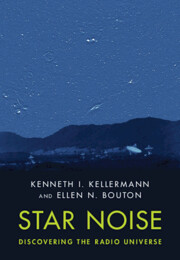Refine search
Actions for selected content:
13587 results in History of science and technology
Preface
-
- Book:
- Star Noise: Discovering the Radio Universe
- Published online:
- 04 May 2023
- Print publication:
- 11 May 2023, pp xv-xviii
-
- Chapter
- Export citation
3 - Radio Galaxies
-
- Book:
- Star Noise: Discovering the Radio Universe
- Published online:
- 04 May 2023
- Print publication:
- 11 May 2023, pp 71-89
-
- Chapter
- Export citation
Index
-
- Book:
- Star Noise: Discovering the Radio Universe
- Published online:
- 04 May 2023
- Print publication:
- 11 May 2023, pp 389-396
-
- Chapter
- Export citation
9 - Radio Studies of the Moon and Planets
-
- Book:
- Star Noise: Discovering the Radio Universe
- Published online:
- 04 May 2023
- Print publication:
- 11 May 2023, pp 208-238
-
- Chapter
- Export citation
Bibliography
-
- Book:
- Star Noise: Discovering the Radio Universe
- Published online:
- 04 May 2023
- Print publication:
- 11 May 2023, pp 353-387
-
- Chapter
- Export citation
10 - Testing Gravity
-
- Book:
- Star Noise: Discovering the Radio Universe
- Published online:
- 04 May 2023
- Print publication:
- 11 May 2023, pp 239-258
-
- Chapter
- Export citation
6 - The Cosmic Microwave Background
-
- Book:
- Star Noise: Discovering the Radio Universe
- Published online:
- 04 May 2023
- Print publication:
- 11 May 2023, pp 143-160
-
- Chapter
- Export citation
Notes
-
- Book:
- Star Noise: Discovering the Radio Universe
- Published online:
- 04 May 2023
- Print publication:
- 11 May 2023, pp 318-346
-
- Chapter
- Export citation
7 - Interplanetary Scintillations, Pulsars, Neutron Stars, and Fast Radio Bursts
-
- Book:
- Star Noise: Discovering the Radio Universe
- Published online:
- 04 May 2023
- Print publication:
- 11 May 2023, pp 161-180
-
- Chapter
- Export citation
Introduction
-
- Book:
- Star Noise: Discovering the Radio Universe
- Published online:
- 04 May 2023
- Print publication:
- 11 May 2023, pp 1-4
-
- Chapter
- Export citation
8 - Interstellar Atoms, Molecules, and Cosmic Masers
-
- Book:
- Star Noise: Discovering the Radio Universe
- Published online:
- 04 May 2023
- Print publication:
- 11 May 2023, pp 181-207
-
- Chapter
- Export citation
Copyright page
-
- Book:
- Star Noise: Discovering the Radio Universe
- Published online:
- 04 May 2023
- Print publication:
- 11 May 2023, pp iv-iv
-
- Chapter
- Export citation
Journal Abbreviations Used
-
- Book:
- Star Noise: Discovering the Radio Universe
- Published online:
- 04 May 2023
- Print publication:
- 11 May 2023, pp 350-352
-
- Chapter
- Export citation
Glossary: Abbreviations and Acronyms
-
- Book:
- Star Noise: Discovering the Radio Universe
- Published online:
- 04 May 2023
- Print publication:
- 11 May 2023, pp 347-349
-
- Chapter
- Export citation
11 - If You Build It, They Will Come
-
- Book:
- Star Noise: Discovering the Radio Universe
- Published online:
- 04 May 2023
- Print publication:
- 11 May 2023, pp 259-290
-
- Chapter
- Export citation
1 - A New Window on the Universe
-
- Book:
- Star Noise: Discovering the Radio Universe
- Published online:
- 04 May 2023
- Print publication:
- 11 May 2023, pp 5-40
-
- Chapter
-
- You have access
- HTML
- Export citation
Suggested Reading
-
- Book:
- Star Noise: Discovering the Radio Universe
- Published online:
- 04 May 2023
- Print publication:
- 11 May 2023, pp 388-388
-
- Chapter
- Export citation
Epigraph
-
- Book:
- Star Noise: Discovering the Radio Universe
- Published online:
- 04 May 2023
- Print publication:
- 11 May 2023, pp v-vi
-
- Chapter
- Export citation

Star Noise: Discovering the Radio Universe
-
- Published online:
- 04 May 2023
- Print publication:
- 11 May 2023
Picturing Chinese science: wartime photographs in Joseph Needham's science diplomacy
-
- Journal:
- The British Journal for the History of Science / Volume 56 / Issue 2 / June 2023
- Published online by Cambridge University Press:
- 04 May 2023, pp. 185-203
- Print publication:
- June 2023
-
- Article
-
- You have access
- Open access
- HTML
- Export citation
